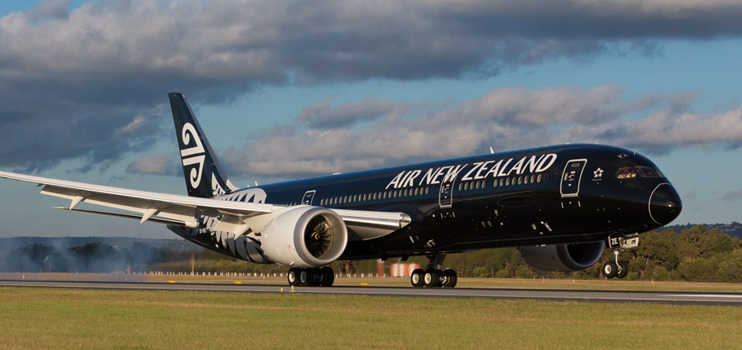An optimistic Air New Zealand is planning for higher than anticipated capacity growth in 2018, despite a 17.4 per cent fall in annual net profit to $NZ382 million ($US278m).
The Kiwi carrier’s 2016-17 pre-tax earnings of $NZ527m were down from $NZ663m the year before but were still the second highest in the airline’s history.
The result came as the airline faced what chief executive Chritsoipher Luxon described as an unprecedented increase in the level of competition from some of the world’s largest airlines.
But management believes it will be able to improve on the 2017 result in the current financial year and has boosted its group capacity growth forecast to 4 to 6 percent.
AirNZ has been buffeted by new non-stop services from Gulf carriers, additional competition from Chinese competitors and increased pressure from US airlines.
The increased competition was reflected in a 5 per cent fall in yield and 2.3 per cent drop in operating revenue, to $NZ5.1 billion, despite a 5.2 per cent rise in group passenger numbers.
“We knew there would be an impact as we moved very quickly from a relatively benign competitive environment to one that was filled with a number of new carriers,” Luxon said during a briefing.
“In that context, I’m extremely pleased with how we responded to that competition and the momentum we saw towards the end of the year.’’
The AirNZ chief pointed to recent decisions by competitors to reduce capacity as supporting the airline’s view of a stronger revenue environment in the coming year.
These included an announcement by US giant American Airlines, which entered the New Zealand market in mid-2016, that it would switch its Auckland service from year-round to seasonal. It recently announced a further reduction in 2018 to a seasonal schedule between October and March.
Other examples included a decision by United Airlines to limit its services to the summer season, an Emirates move to drop its Sydney-Auckland service and reduction in New Zealand domestic capacity by Jetstar.
The group capacity growth forecast to 4 to 6 per cent was an increase on the airline’s June estimate of 3 to 4 per cent. But Luxon emphasised it was based on increased utilisation of the aircraft fleet already planned for 2018.
A breakdown included 4 to 6 per cent growth in domestic markets, 8 to 10 per cent on Tasman and Pacific Island routes and 3 to 5 per cent for international long-haul.
AirNZ continued to see strong underlying demand in its domestic and Pacific Island markets and Luxon said its strategy was to continue to grow jet routes into key domestic city centres, particularly Queenstown.
“We plan to add over 60,000 extra seats to our regional schedule alone over the summer months across the network, which includes additional services to Napier and Nelson,’’ he said
Pacific island travel accounted for almost a third of nearly 12 per cent growth in Kiwi outbound travel for the 12 months.
Luxon flagged increase services to Bali and Honolulu, noting the latter continued to see strong demand, particularly from premium traffic, after the deployment of the Boeing 787.
He said signs of capacity rationalisation on trans-Tasman routes were seeing improved revenue dynamics merge “albeit from a low base”.
There was a plan to upgrade routes such as Adelaide to the 787 Dreamliner to benefit from aircraft economics, stimulate premium traffic and support the campaign to convince Australians to use Auckland as hub for travel to North and South America.
“Overall, we’re optimistic on the revenue momentum on the trans-Tasman after a year of excess capacity impacting pricing,’’ he said.
Long-haul was the sector most affected by the influx of new competition but Luxon said North American routes were still showing strong demand despite a 30 per cent capacity growth in the last year.
He said the airline’s Auckland-Houston route continued to perform well, particularly with connecting US customers.
“As we continue to strengthen our Houston route this year we will be adding frequencies and deploying the new code two 787 Dreamliner with 275 seats,’’ he said. “It has fewer economy seats and adds 21additional premium seats to capture the demand in that market.”
Vancouver is also poised for an extended peak season and an additional service per week while on Asian routes, AirNZ expects revenue to improve in the second half of 2018 as industry growth is absorbed.
Luxon said the airline continued to be optimistic about Singapore, where it works with Star Alliance partner Singapore Airlines, and it would continue to focus on strategically growing Japan.
He said he was pleased to see Japan’s GDP had grown for six consecutive quarters and AirNZ would work in the next few years to grow its three times weekly Haneda (Tokyo) service and its daily Narita flights.
Commenting on the outlook for the year, Luxon said the 2017 earnings provided the airline “with a sustainable platform for future performance’’.
“As we look forward to the year ahead, we’re optimistic about the overall market dynamics,’’ he said. “Based on current market conditions and assuming fuel prices remain at $US60 per barrel, which represents the average over the past two months, we are aiming to improve upon 2017 earnings.’’
The result saw the airline’s 8500 staff score bonuses of up to $NZ1700. It also declared a fully imputed dividend of 11 NZ cents, up 10 per cent on last year, to bring full-year declared ordinary dividends to 21 NZ cents per share.
























